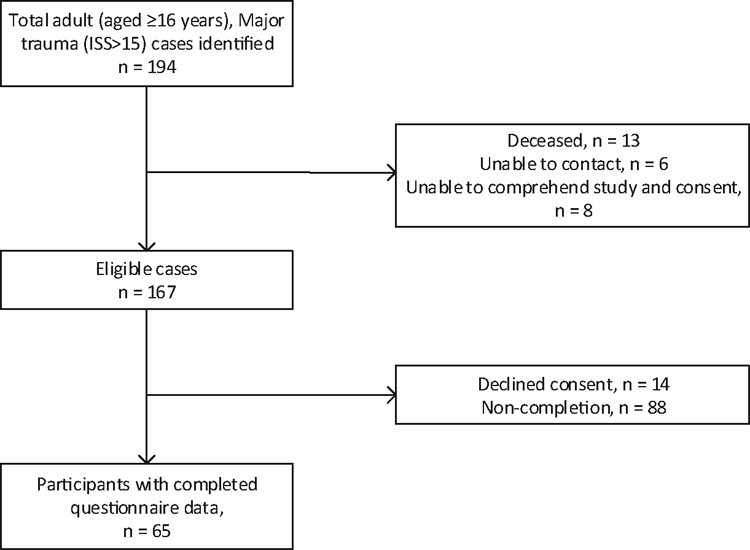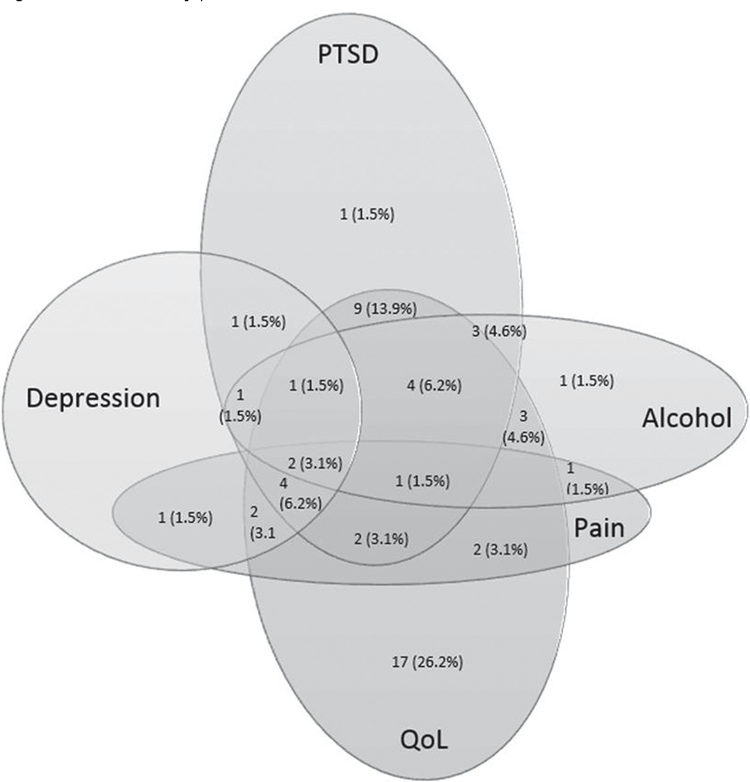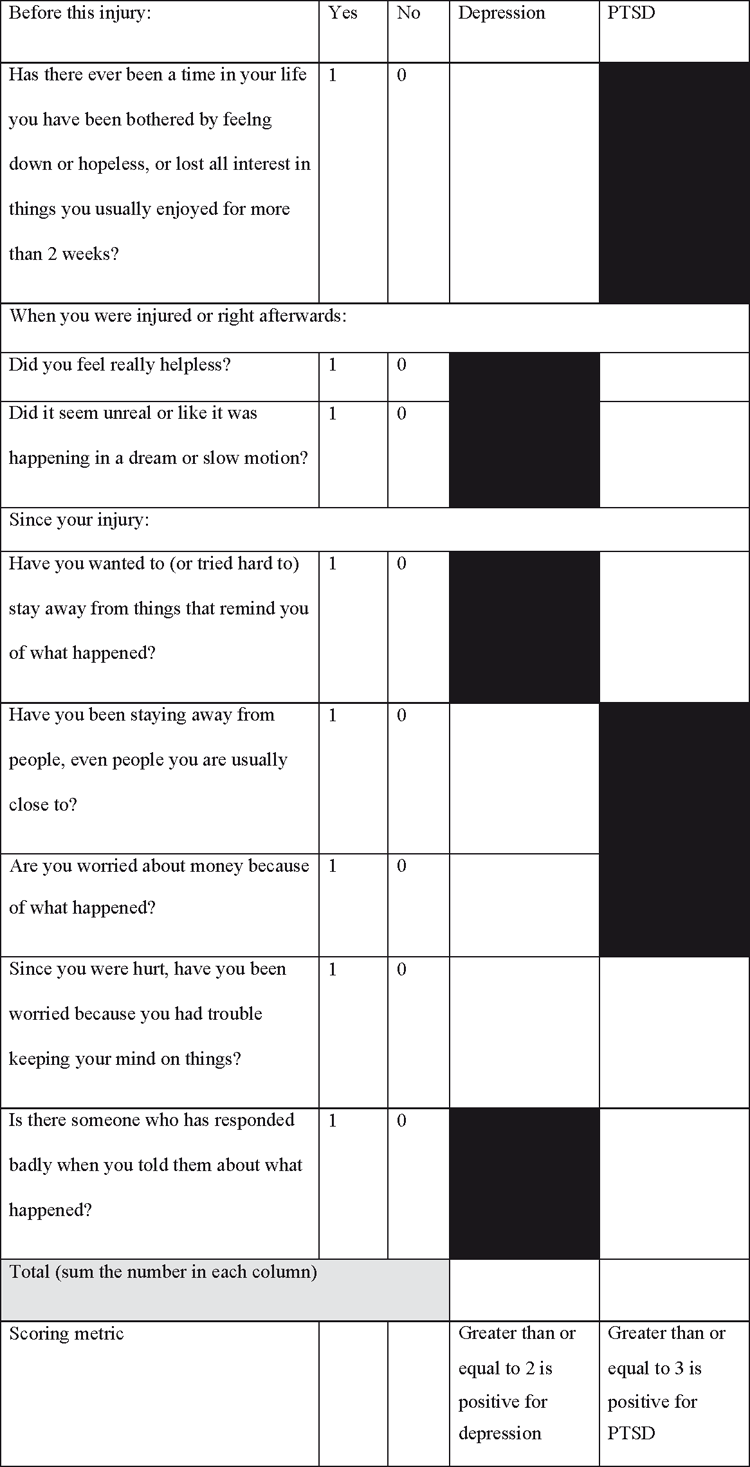Psychiatric comorbidities in adult survivors of major trauma: findings from the Midland Trauma Registry
E. E. Spijker 1 , K. Jones 2 , J. W. Duijff 1 , A. Smith 1 , G. R. Christey 11 Midland Trauma Research Centre, Hamilton, New Zealand
2 National Institute for Stroke and Applied Neurosciences, Auckland University of Technology, Auckland, New Zealand
Correspondence to: Grant R. Christey, Midland Trauma System, Level 4, Meade Clinical Centre, Waikato Hospital, Pembroke Street, Hamilton 3204, New Zealand. Email: grant.christey@waikatodhb.health.nz
Journal of Primary Health Care 10(4) 292-302 https://doi.org/10.1071/HC17091
Published: 7 December 2018
Journal Compilation © Royal New Zealand College of General Practitioners 2018.
This is an open access article licensed under a Creative Commons Attribution-NonCommercial-NoDerivatives 4.0 International License.
Abstract
INTRODUCTION: Information for primary care providers about the outcomes of adult survivors of major medical trauma in the first year of recovery is not widely available. In particular, risks of impairment across multiple domains of functioning are poorly understood.
AIM: To determine the extent to which adults’ experience impaired health-related quality of life (QoL), symptoms of post-traumatic stress disorder, depression, chronic pain and harmful alcohol use during the year following major trauma, and to identify factors associated with outcomes.
METHODS: Adults (aged ≥16 years) admitted to Waikato Hospital following major trauma sustained in Waikato District between 1 June 2010 and 1 July 2011 were sent a questionnaire in their first year of recovery. They were asked about their QoL, mental health, experiences of pain, post-traumatic stress disorder symptoms and use of alcohol.
RESULTS: Sixty-five questionnaires were completed (40% response rate). In the year following major trauma, trauma survivors met criteria for post-traumatic stress disorder (45%), harmful alcohol use (26%), moderate to severe chronic pain (23%) and depression (18%). Reports of poor health-related QoL were common, ranging from self-care difficulties (31%) to pain and discomfort (72%). Younger age, previous psychiatric illness, substance use, intensive care unit admission and length of hospitalisation were associated with symptoms. Thirty-seven adults (57%) reported symptoms in at least two domains.
DISCUSSION: A significant proportion of adults experience adverse psychosocial outcomes in the first year following major trauma. Screening and management of potentially comorbid psychosocial needs could improve care and outcomes for survivors.
KEYWORDS: depression; screening; health research; alcohol
| WHAT GAP THIS FILLS |
| What is already known: Psychiatric co-morbidities among survivors of civilian trauma, war or natural disasters are well-known and typically related to the witnessing of horror or the presence of imminent threats to the life of the survivor or their friends and family. Despite potentially devastating consequences, the nature of psychiatric comorbidities among survivors of major trauma in New Zealand are not well-known. |
| What this study adds: Adult survivors of major trauma in New Zealand face risks for not only post-traumatic stress disorder in the year following injury, but also harmful alcohol use, depression, pain and adversely affected QoL. Standardised inpatient screening and primary care follow-up offers the potential to provide additional support and enhance recovery. |
Introduction
Follow-up care of adult survivors of major trauma is often focused on surgical management and physical rehabilitation with less attention to psychosocial needs. Adverse emotions and maladaptive responses that are not recognised and managed early may increase risks for developing a range of psychiatric difficulties. Affecting 10–39% of trauma survivors,1 post-traumatic stress disorder (PTSD) is one of the most common chronic psychological sequelae of traumatic experiences.
Post-traumatic stress disorder symptoms include an intense emotional reaction to the traumatic event, followed by persistent re-experiencing of the traumatic event, numbed emotional responsiveness and avoidance and hyperarousal that do not diminish over time.2,3 Affected people face between two- and six-fold risks for developing psychiatric comorbidities,4,5 and often report diminished functioning, and poorer quality of life (QoL), with greater likelihood of hospitalisation, use of medical care, unemployment and poverty.6–10 Depression is also common following major trauma, with 10% of survivors developing major depression within one year.11
Many studies stress the mental health needs of traumatically injured populations.1,12 Early mental health support can reduce the prevalence of PTSD and comorbid psychological symptoms.13,14 Adults who have experienced trauma may respond positively to early cognitive behavioural and psychopharmacological interventions.15–17 An important first step to minimising treatment delays is enhanced understanding of the scope of the issue among adult survivors of trauma. Yet, like many countries, New Zealand lacks national guidelines for the psychiatric treatment of major trauma patients.
The current research was undertaken to provide a starting point for improved understanding of the nature and extent of not only PTSD, but also psychosocial comorbidities that are experienced by adult survivors of major trauma in New Zealand. This information is required to support primary care providers in identifying PTSD and common comorbid psychological symptoms in their patients and avoiding under-treatment in primary care.18,19 Drawing on data from a regional cohort of adult survivors of major trauma in the Waikato district, the aims of this study were to enhance understanding of the nature of psychiatric comorbidities in the first year of recovery and to identify factors associated with poor outcomes.
Methods
The study was approved by the Northern Y Regional Ethics Committee (NTY/11/06/065).
Participants were identified by retrospective review of Midland Trauma System (www.midlandtrauma.nz/about-mts/) registry data for all adult survivors of major trauma (aged ≥16 years at injury) who were admitted to Waikato Hospital between 1 June 2010 and 1 July 2011. Registry data do not include cases of sustained hanging, drowning or asphyxiation, insufficiency or periprosthetic fractures, poisoning, ingested foreign body, exertional injuries, injuries sustained as a direct result of pre-existing medical conditions (e.g. fall-related injuries sustained as a result of a stroke) or patients who were injured more than 14 days before admission. People unable to provide informed written consent were also excluded. Major trauma was defined as an Injury Severity Score (ISS) of ≥15.20 The ordinal ISS scale ranges from 0 to 75 and is calculated by summing the squares of the highest Abbreviated Injury Scale (AIS),21 in the three most severely injured AIS body regions (head/neck/cervical spine, face, chest/thoracic spine, abdomen/pelvic content/lumbar spine, extremities/pelvic girdle, external/integument). Despite concerns the ISS is outdated, has impaired discriminatory and predictive power, is complicated to score22 and lacks a standard categorisation scheme,23 the ISS is the main tool used worldwide in trauma monitoring and evaluation, rendering it the ‘gold standard’ in trauma severity grading.24
Following medical record checks for eligibility and consent procedures, potential participants were contacted by a researcher and invited to complete a survey that included standardised questionnaires to assess psychiatric wellbeing and QoL. Demographic information and medical details were also collected using self-report and available registry data.
The EuroQol (EQ-5D-3L) assesses health-related QoL in five domains that may be affected by injury (mobility, self-care, usual activities, pain and discomfort, anxiety and depression).25 Indication of impaired QoL used a scale of 0 = ‘no problems’ to 3 = ‘unable or extreme problems’, and based on functioning ‘today’, a score of 2 or 3. The EuroQol has proven validity and reliability across many conditions and populations, including cancer,26 diabetes,27 respiratory28 and cardiovascular diseases.29
The Post-Traumatic Stress Disorder Checklist (PTSD checklist) specifically aligns with Diagnostic and Statistical Manual of Mental Disorders, Fourth Edition (DSM-IV) criteria for PTSD,3 assessing three main syndromes: re-experiencing, avoidance and hyperarousal. Items are answered in response to an identified ‘stressful experience’.30 Respondents indicate how much they have been bothered by problems in the past month, ranging from ‘not at all’ to ‘extremely’. Higher scores indicate a greater number of and more severe symptoms. Total score PTSD cut-offs are 44 for motor vehicle accidents30 and 30 for primary care patients.31 A cut-off of 36 was used in the current study to avoid missing cases, given 48% of major trauma patients are not involved in a motor vehicle accident.32 The PTSD checklist has demonstrated internal consistency ( = 0.94) and test-retest reliability.33
The 21-item Beck Depression Inventory (BDI)34 screens for depression symptoms in the past 2 weeks (i.e. sense of failure, pessimism, guilt). Using a scale of 0 = ‘least’ to 3 = ‘most’, higher total scores indicate greater depression. Ranging from 0–63, total scores ≥17 indicate moderate–severe depression.34 The BDI has proven test-retest reliability, internal consistency, and is suitable for use in depressed and non-depressed samples.34
The Visual Analogue Scale for Pain35 is a single-item scale using a 10-cm vertical line. Ranging from 0 = ‘no pain’ and 10 = ‘worst possible pain’, participants indicate their pain level during the previous 3 months. Scores ranging from 0–100 are based on the distance (mm) between the ‘no pain’ anchor and the participant’s mark. With proven test-retest reliability, scores >45 mm indicate moderate–severe pain.36
The 10-item Alcohol Use Disorders Identification Test screens for harmful alcohol use.37 Using a scale of 0–4, items assess alcohol consumption, dependence and alcohol-related consequences. Ranging from 0–40, total scores ≥8 indicate harmful alcohol use.38 As recommended, a cut-off of 7 was applied to people aged ≥65 years.39 In general populations, its performance is outstanding to good in identifying DSM-IV-Alcohol Dependence, DMS-IV-Alcohol Abuse or risk drinking,40 with proven test-retest properties.41,42
Potential factors associated with poor outcomes included patient characteristics (age at injury, gender and self-reported ethnicity, marital status, education level), history of psychiatric illness (depression, post-traumatic stress disorder, personality disorder, anxiety disorder, or other), chronic illness (non-psychiatric) and substance use. Injury factors identified from medical records included traumatic brain injury (TBI), intensive care unit (ICU) admission, length of hospital stay, injury mechanism and ISS. Injury mechanisms were categorised using the International Classification of Disease (ICD–10) external cause codes.43 ISS was based on a recommended combination of the Glasgow Coma Scale, age and systolic blood pressure.20
Data analysis
Survey data were entered into Excel (Microsoft Corporation, Redmond, WA, USA) and exported to SPSS version 21 (SPSS Inc., Chicago, IL, USA) for analysis. Response frequencies were tabulated for all criteria and comorbidities. Both t-tests and chi-square tests compared the characteristics of patients who did or did not meet each criterion for each outcome of interest.
Results
Sixty-five adults (40%) completed the survey (Fig. 1). People who did (n = 65) and did not (n = 102) complete the survey did not differ on age, ethnicity, injury mechanism and severity (P > 0.05). People who did not respond were more likely to be male (P = 0.03) and admitted to ICU (P = 0.02, Table 1).
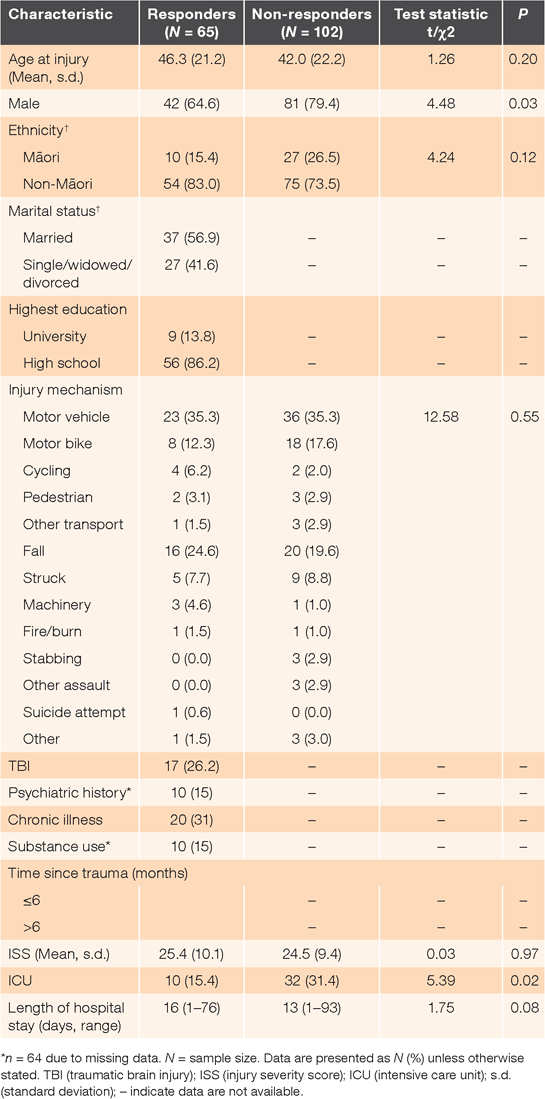
|
Self-reported psychiatric outcomes
Twenty-nine adults (45%) met PTSD criteria. Twelve (18%) met criteria for depression, 15 (23%) for moderate–severe pain and 17 (26%) for alcohol use. Forty-seven (72%) reported extreme QoL problems related to usual activities or pain and discomfort, and 27 (42%) had anxiety or depression (Table 2).
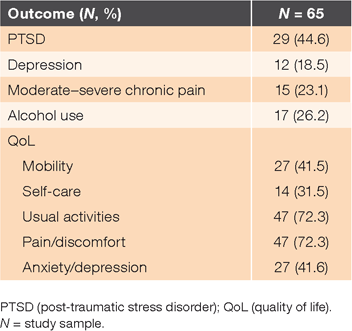
|
Factors associated with meeting criteria
Younger age (16–50 years) was associated with PTSD (P = 0.04), depression (P = 0.02) and harmful alcohol use (P < 0.001). ICU admission was associated with PTSD (P = 0.02) and moderate–severe pain (P < 0.001). More than 10 days of hospitalisation was associated with impaired QoL (P = 0.001) and moderate–severe pain (P = 0.04). History of psychiatric illness was associated with PTSD (P = 0.001), and substance use with harmful alcohol use (P = 0.02) (Table 3).

|
Patterns of comorbidities
Thirty-seven adults (57%) met cut-off criteria in two or more domains (Fig. 2). Of those meeting the PTSD cut-off, 28 (97%) had at least one other psychiatric comorbidity. Nine (14%) did not meet any cut-off criteria (Table 4).
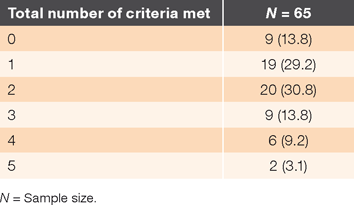
|
Discussion
We found that nearly half of all adult survivors experienced PTSD symptoms in the first year after injury. Approximately one-quarter of adults reported harmful alcohol use or moderate–severe pain, and reports of impaired QoL were common. Younger age (16–50 years), a history of psychiatric illness or substance use, ICU admission and spending >10 days in hospital were associated with poorer outcomes. Of concern, one in five adults reported two or more psychiatric comorbidities. To our knowledge, this study is the first to examine such a broad range of outcomes in adult survivors of major trauma in New Zealand.
The prevalence of PTSD in the current study is similar to previous reports. Blanchard et al. found that 39% of trauma survivors met PTSD criteria at 1–4 months post-trauma or hospital discharge.44 While the current study screened for rather than diagnosed PTSD, our findings provide further evidence of risks for PTSD symptoms up to 1 year following trauma. Findings of links between major trauma and comorbid difficulties are also consistent with overseas evidence.45 An Australian survey found that 24% of trauma survivors with PTSD also had an alcohol use disorder.45 Using the Structured Clinical Interview for DSM-IV,46 O’Donnell et al. found PTSD and major depressive disorder were most common, with 10.4% and 10.1% reporting major depression at 3 and 12 months respectively.12
While higher rates of depression were found in the current study (18.5%), the validity of using self-report questionnaires such as the BDI in medical populations has been questioned. Several BDI items can be attributed to medical conditions (e.g. sleep disturbances, fatigue). Subsequently, there are concerns that reports of depression may be over-inflated in this population. However, the exclusion of somatic symptoms when assessing depression may reduce sensitivity to detect depression, prolong symptoms and impede long-term recovery.47 The complexities of assessing depression among trauma patients are further complicated by overlapping symptoms in depression and chronic pain.48 Nevertheless, our findings overlap with prior research highlighting comorbid difficulties among adult survivors of major trauma.
Study findings also highlight the value of identifying risk factors associated with and screening for PTSD and other comorbidities, particularly among younger patients following major trauma. Ameratunga et al. (2009) examined PTSD prevalence among 268 adult survivors of serious car crashes13 (aged ≥16 years) and, consistent with our results, found that PTSD was more common in people aged <45 years at injury than in older adults. Given longer-term management of trauma patients is often a primary care responsibility, it is important for primary care clinicians to be aware of the increased risks for psychiatric comorbidities and to consider ways to identify patients at risk.
A key challenge in hospitals is to distinguish between transient distress and risk for subsequent development of serious psychiatric disorder. One way to identify early high risk during the in-patient stage could involve the standardised review of patient medical records for known risk factors identified in the current study and in overseas populations. For example, Russo et al. (2013) examined a population-based sample of 878 trauma survivors in an effort to develop and test a PTSD risk prediction model.49 Consistent with our findings, risk factors for later PTSD included ICU admission, current or history of substance use or any psychiatric disorder. Additional risk factors were female gender, minority ethnicity, prior in-patient hospitalisations, intentional injury, insurance status, tobacco use and history of PTSD. Additional risk factors in our sample included younger age at injury and longer hospitalisation. Given that prior hospitalisations, tobacco use, intentional injury and a history of PTSD were not specifically examined in the current study, these additional risk factors cannot be discounted and may also be relevant in New Zealand.
While yet to be fully validated in New Zealand, all of these risk factors provide a starting point to informing a standardised medical record review before patient discharge. Using a cut off of three or more risk factors as recommended by Russo et al., adults found to be at elevated risk could then be triaged before discharge to facilitate further monitoring and support. Alternatively, brief screening measures such as the Injured Trauma Survivor Screen (ITSS)50 or the 10-item Posttraumatic Adjustment Scale (PAS)51 could be used to identify adults at risk. This status could then be indicated in discharge summaries to flag follow-up in primary care and prompt systematic written patient information at discharge. Alternatively, all trauma survivors could be provided with information at discharge to avoid missing any at-risk patients, with recommendations to follow-up any future concerns with their primary care provider.
Information concerning PTSD and depression is currently available on the Ministry of Health and Mental Health Foundation of New Zealand websites. We recommend an information leaflet specifically targeting adult survivors of major trauma and their families. This resource should aim to inform patients and their families/whanau about symptoms consistent with PTSD and other common comorbidities that follow trauma. It should also advise on how to recognise maladaptive coping strategies, the importance of social support and avenues for accessing support beyond the family.52
Strengths and limitations
Limitations of this study include variability in the timing of questionnaire completion up to 1-year post-trauma, sole reliance on self-report screening measures and its small sample size. Given avoidance is a symptom of PTSD, it is possible that people with PTSD and depression were less likely to complete our questionnaire. Alternatively, it is also possible that people who have recovered well are busy participating in life and did not see any value in completing and returning the questionnaire. A future study that emphasises to potential participants the value of learning more about adults who have or have not recovered well from trauma may achieve enhanced response rates from patients. Further, including consistently timed in-person assessments and adopting recommendations to use a combination of methods,53 such as formal diagnoses (i.e. the Structured Clinical Interview for DSM-IV)54 and subjective, self-report measures, could improve comparability with other studies and enhance insight into the full spectrum of needs of trauma survivors. Qualitative research methods could also help to better understand what life is like for survivors of major trauma and to identify unmet needs and barriers to service access. Nonetheless, the current study achieved a 40% postal response rate in a population who can be difficult to engage, included all causes of major trauma and broadly examined the presence of psychiatric comorbidities.
Implications for primary care
While conclusions should be drawn with caution, study findings confirm the need to further support people who survive major trauma, at least throughout the first year following injury. At present in New Zealand, there is no systematic follow up of major trauma patients at primary care level. Some major trauma patients may receive assistance from the Accident Compensation Corporation (ACC) covering treatment and support for people with physical injuries and related mental injuries, including PTSD. However, in the absence of routine in-patient and out-patient screening in primary care, many cases of PTSD and depression following major trauma may be overlooked.
One important first step in outpatient screening after discharge might include the standardised use of predictive screeners for PTSD and depression (the two most commonly identified outcomes in the current study) among survivors of major trauma. To our knowledge, no predictive screeners for the future development of PTSD and depression have been developed for use in New Zealand. However, several predictive screeners have been used in primary care in other countries,51,55–57 some of which screen exclusively for PTSD (Breslau’s Short Screening Scale) or for several psychiatric disorders (My Mood Monitor Checklist). We identified only three screening measures specifically aimed at detecting risk for PTSD and depression following major trauma.
As an alternative to the ITSS and PAS that may be suitable for primary care, Richmond et al. (2011) propose an eight-item, simple screener for PTSD and depression that relies only on information that is readily available from medical records, patients or families (Fig. 3).58 Easily scored by busy clinicians, this tool has proven useful at 1–2 weeks post-injury in identifying patients at risk for developing PTSD and depression within 6 months. With proven sensitivity (0.81 depression, 1.0 for PTSD), evidence suggests that patients who screen negative can, with confidence, be screened out from further monitoring for PTSD or depression. However, these screening tools require further validation in terms of longer-term administration (beyond up to 2-weeks post-injury) and potential variations in performance by age, gender, ethnic groups and in geographically diverse locations.
Nevertheless, a 2013 systematic review of screening measures for PTSD in primary care55 found that, regardless of the screening tool used, 63% of patients and 80% of primary care providers found the screening process valuable to facilitate discussion around patient feelings and emotional symptoms. Therefore, while priority screeners are yet to be identified, research shows that it is possible to use a brief screener in primary care to identify trauma patients who are likely to develop PTSD and depression within 6 months following hospital discharge. Such a screening measure could provide a trauma survivor template in electronic patient management systems to flag key questions to be revisited at follow-up appointments for survivors of major trauma. We do not suggest that all major trauma patients are screened. Rather, people who screen positive for risk of developing PTSD or depression could be engaged in further discussion and potential follow up, which may include psychological assessment.
In conclusion, this study suggests that better screening for, and subsequent follow up and treatment of, mental health problems in adult survivors of major trauma is required and could lead to significant improvements in their wellbeing and recovery and careful allocation of costly and limited mental health resources.
COMPETING INTERESTS
None.
References
[1] Bryant RA, O’Donnell ML, Creamer M, et al. The psychiatric sequelae of traumatic injury. Am J Psychiatry. 2010; 167 312–20.| The psychiatric sequelae of traumatic injury.Crossref | GoogleScholarGoogle Scholar |
[2] Lancaster CL, Teeters JB, Gros DF, Back SE. Posttraumatic stress disorder: overview of evidence-based assessment and treatment. J Clin Med. 2016; 5 105
| Posttraumatic stress disorder: overview of evidence-based assessment and treatment.Crossref | GoogleScholarGoogle Scholar |
[3] American Psychiatric Association. Diagnostic and Statistical Manual of Mental Disorders. Washington, DC: American Psychiatric Association; 1994.
[4] Kessler RC, Sonnega A, Bromet E, et al. Posttraumatic stress disorder in the National Comorbidity Survey. Arch Gen Psychiatry. 1995; 52 1048–60.
| Posttraumatic stress disorder in the National Comorbidity Survey.Crossref | GoogleScholarGoogle Scholar |
[5] Breslau N, Davis GC, Andreski P, Peterson E. Traumatic events and posttraumatic stress disorder in an urban population of young adults. Arch Gen Psychiatry. 1991; 48 216–22.
| Traumatic events and posttraumatic stress disorder in an urban population of young adults.Crossref | GoogleScholarGoogle Scholar |
[6] Breslau N. The epidemiology of trauma, PTSD, and other posttrauma disorders. Trauma Violence Abuse. 2009; 10 198–210.
| The epidemiology of trauma, PTSD, and other posttrauma disorders.Crossref | GoogleScholarGoogle Scholar |
[7] Marshall RD, Olfson M, Hellman F, et al. Comorbidity, impairment, and suicidality in subthreshold PTSD. Am J Psychiatry. 2001; 158 1467–73.
| Comorbidity, impairment, and suicidality in subthreshold PTSD.Crossref | GoogleScholarGoogle Scholar |
[8] Smith MW, Schnurr PP, Rosenheck RA. Employment outcomes and PTSD symptom severity. Ment Health Serv Res. 2005; 7 89–101.
| Employment outcomes and PTSD symptom severity.Crossref | GoogleScholarGoogle Scholar |
[9] Kartha A, Brower V, Saitz R, et al. The impact of trauma exposure and post-traumatic stress disorder on healthcare utilization among primary care patients. Med Care. 2008; 46 388–93.
| The impact of trauma exposure and post-traumatic stress disorder on healthcare utilization among primary care patients.Crossref | GoogleScholarGoogle Scholar |
[10] Zen AL, Whooley MA, Zhao S, Cohen BE. Post-traumatic stress disorder is associated with poor health behaviors: findings from the heart and soul study. Health Psychol. 2012; 31 194–201.
| Post-traumatic stress disorder is associated with poor health behaviors: findings from the heart and soul study.Crossref | GoogleScholarGoogle Scholar |
[11] O’Donnell ML, Creamer M, Pattison P. Posttraumatic stress disorder and depression following trauma: understanding comorbidity. Am J Psychiatry. 2004; 161 1390–6.
| Posttraumatic stress disorder and depression following trauma: understanding comorbidity.Crossref | GoogleScholarGoogle Scholar |
[12] O’Donnell ML, Creamer M, Pattison P, Atkin C. Psychiatric morbidity following injury. Am J Psychiatry. 2004; 161 507–14.
| Psychiatric morbidity following injury.Crossref | GoogleScholarGoogle Scholar |
[13] Ameratunga S, Tin TS, Coverdale J, et al. Posttraumatic stress among hospitalized and nonhospitalized survivors of serious car crashes: a population-based study. Psychiatr Serv. 2009; 60 402–4.
| Posttraumatic stress among hospitalized and nonhospitalized survivors of serious car crashes: a population-based study.Crossref | GoogleScholarGoogle Scholar |
[14] Linares IMP, Corchs FDF, Chagas MHN, et al. Early interventions for the prevention of PTSD in adults: a systematic literature review. Arch Clin Psychiatry. 2017; 44 23–9.
| Early interventions for the prevention of PTSD in adults: a systematic literature review.Crossref | GoogleScholarGoogle Scholar |
[15] Roberts NP, Kitchiner NJ, Kenardy J, Bisson JL. Systematic review and meta-analysis of multiple-session early interventions following traumatic events. Am J Psychiatry. 2009; 166 293–301.
| Systematic review and meta-analysis of multiple-session early interventions following traumatic events.Crossref | GoogleScholarGoogle Scholar |
[16] Bisson JI, Andrew M. Psychological treatment of post-traumatic stress disorder (PTSD). Cochrane Database Syst Rev. 2007; 18
[17] Bryant RA, Creamer M, O’Donnell M, et al. A study of the protective function of acute morphine administration on subsequent posttraumatic stress disorder. Biol Psychiatry. 2009; 65 438–40.
| A study of the protective function of acute morphine administration on subsequent posttraumatic stress disorder.Crossref | GoogleScholarGoogle Scholar |
[18] Graves RE, Freedy JR, Aigbogun NU, et al. PTSD treatment of African American adults in primary care: the gap between current practice and evidence-based treatment guidelines. J Natl Med Assoc. 2011; 103 585–93.
| PTSD treatment of African American adults in primary care: the gap between current practice and evidence-based treatment guidelines.Crossref | GoogleScholarGoogle Scholar |
[19] Magruder KM, Frueh BC, Knapp RG, et al. Prevalence of posttraumatic stress disorder in Veterans Affairs primary care clinics. Gen Hosp Psychiatry. 2005; 27 169–79.
| Prevalence of posttraumatic stress disorder in Veterans Affairs primary care clinics.Crossref | GoogleScholarGoogle Scholar |
[20] Civil ID, Schwab CW. The Abbreviated Injury Scale, 1985 revision: a condensed chart for clinical use. J Trauma Acute Care Surg. 1988; 28 87–90.
| The Abbreviated Injury Scale, 1985 revision: a condensed chart for clinical use.Crossref | GoogleScholarGoogle Scholar |
[21] Baker SP, O’Neill B, Haddon W, Long WB. The injury severity score: a method for describing patients with multiple injuries and evaluating emergency care. J Trauma. 1974; 14 187–96.
| The injury severity score: a method for describing patients with multiple injuries and evaluating emergency care.Crossref | GoogleScholarGoogle Scholar |
[22] Osler T, Baker SP, Long W. A modification of the injury severity score that both improves accuracy and simplifies scoring. J Trauma: Inj Infect Crit Care. 1997; 43 922–6.
| A modification of the injury severity score that both improves accuracy and simplifies scoring.Crossref | GoogleScholarGoogle Scholar |
[23] Stevenson M, Segui-Gomez M, Lescohier I, et al. An overview of the injury severity score and the new injury severity score. Inj Prev. 2001; 7 10–3.
| An overview of the injury severity score and the new injury severity score.Crossref | GoogleScholarGoogle Scholar |
[24] Lavoie A, Moore L, LeSage N, Liberman M, Sampalis JS. The Injury Severity Score or the New Injury Severity Score for predicting intensive care unit admission and hospital length of stay? Injury. 2005; 36 477–83.
| The Injury Severity Score or the New Injury Severity Score for predicting intensive care unit admission and hospital length of stay?Crossref | GoogleScholarGoogle Scholar |
[25] World Health Organization. International Classification of Disabilities, Functioning and Health. Geneva, Switzerland: World Health Organization; 2001.
[26] Pickard AS, Wilke CT, Lin HW, Lloyd A. Health utilities using the EQ-5D in studies of cancer. Pharmacoeconomics. 2007; 25 365–84.
| Health utilities using the EQ-5D in studies of cancer.Crossref | GoogleScholarGoogle Scholar |
[27] Janssen MF, Lubetkin EI, Sekhobo JP, Pickard AS. The use of the EQ-5D preference-based health status measure in adults with Type 2 diabetes mellitus. Diabet Med. 2011; 28 395–413.
| The use of the EQ-5D preference-based health status measure in adults with Type 2 diabetes mellitus.Crossref | GoogleScholarGoogle Scholar |
[28] Simon Pickard A, Wilke C, Jung E, et al. Use of a preference-based measure of health (EQ-5D) in COPD and asthma. Respir Med. 2008; 102 519–36.
| Use of a preference-based measure of health (EQ-5D) in COPD and asthma.Crossref | GoogleScholarGoogle Scholar |
[29] Dyer MTD, Goldsmith KA, Sharples LS, Buxton MJ. A review of health utilities using the EQ-5D in studies of cardiovascular disease. Health Qual Life Outcomes. 2010; 8 13
[30] Blanchard EB, Jones-Alexander J, Buckley TC, Forneris CA. Psychometric properties of the PTSD checklist (PCL). Behav Res Ther. 1996; 34 669–73.
| Psychometric properties of the PTSD checklist (PCL).Crossref | GoogleScholarGoogle Scholar |
[31] Walker EA, Newman E, Dobie DJ, et al. Validation of the PTSD Checklist in an HMO sample of women. Gen Hosp Psychiatry. 2002; 24 375–80.
| Validation of the PTSD Checklist in an HMO sample of women.Crossref | GoogleScholarGoogle Scholar |
[32] Midland Regional Trauma System. Midland Trauma System 2015–2016 Annual Report. Hamilton, New Zealand: Midland Regional Trauma System; 2017.
[33] Ventureyra VAG, Yao S-N, Cottraux J, et al. The validation of the Posttraumatic Stress Disorder Checklist Scale in posttraumatic stress disorder and nonclinical subjects. Psychother Psychosom. 2002; 71 47–53.
| The validation of the Posttraumatic Stress Disorder Checklist Scale in posttraumatic stress disorder and nonclinical subjects.Crossref | GoogleScholarGoogle Scholar |
[34] Farinde A. The Beck Depression Inventory. Pharma Innov J. 2013; 2 56–62.
[35] McCormack HM, Horne DJ, Sheather S. Clinical applications of visual analogue scales: a critical review. Psychol Med. 1988; 18 1007–19.
| Clinical applications of visual analogue scales: a critical review.Crossref | GoogleScholarGoogle Scholar |
[36] Jensen MP, Chen C, Brugger AM. Interpretation of visual analog scale ratings and change scores: a reanalysis of two clinical trials of post-operative pain. J Pain. 2003; 4 407–14.
| Interpretation of visual analog scale ratings and change scores: a reanalysis of two clinical trials of post-operative pain.Crossref | GoogleScholarGoogle Scholar |
[37] Saunders JB, Aasland OG, Babor TF, et al. Development of the alcohol use disorders identification test (AUDIT): WHO collaborative project on early detection of persons with harmful alcohol consumption - II. Addiction. 1993; 88 791–804.
| Development of the alcohol use disorders identification test (AUDIT): WHO collaborative project on early detection of persons with harmful alcohol consumption - II.Crossref | GoogleScholarGoogle Scholar |
[38] Babor TF, Robaina K. The Alcohol Use Disorders Identification Test (AUDIT): A review of graded severity algorithms and national adaptations. Int J Alcohol Drug Res. 2016; 5 17–24.
| The Alcohol Use Disorders Identification Test (AUDIT): A review of graded severity algorithms and national adaptations.Crossref | GoogleScholarGoogle Scholar |
[39] Babor TF, Higgins-Biddle JC, Saunders JB, Monteiro MG. AUDIT: the Alcohol Use Disorder Identification Test: guidelines for use in primary care. Geneva: World Health Organization Department of Mental Health and Substance Dependence; 2001.
[40] Rumpf HJ, Hapke U, Meyer C, John U. Screening for alcohol use disorders and at-risk drinking in the general population: psychometric performance of three questionnaires. Alcohol Alcohol. 2002; 37 261–8.
| Screening for alcohol use disorders and at-risk drinking in the general population: psychometric performance of three questionnaires.Crossref | GoogleScholarGoogle Scholar |
[41] Selin KH. Test-retest reliability of the alcohol use disorder identification test in a general population sample. Alcohol Clin Exp Res. 2003; 27 1428–35.
| Test-retest reliability of the alcohol use disorder identification test in a general population sample.Crossref | GoogleScholarGoogle Scholar |
[42] Lundin A, Hallgren M, Balliu N, Forsell Y. The use of Alcohol Use Disorders Identification Test (AUDIT) in detecting alcohol use disorder and risk drinking in the general population: Validation of AUDIT using schedules for clinical assessment in neuropsychiatry. Alcohol Clin Exp Res. 2015; 39 158–65.
| The use of Alcohol Use Disorders Identification Test (AUDIT) in detecting alcohol use disorder and risk drinking in the general population: Validation of AUDIT using schedules for clinical assessment in neuropsychiatry.Crossref | GoogleScholarGoogle Scholar |
[43] National Centre for Classification in Health. The international statistical classification of diseases and related health problems. Tenth revision, Australian Modification (ICD-10_AM). Sydney, Australia: National Centre for Classification in Health; 2006.
[44] Blanchard EB, Hickling EJ, Taylor AE, Loos W. Psychiatric morbidity associated with motor vehicle accidents. J Nerv Ment Dis. 1995; 183 495–504.
| Psychiatric morbidity associated with motor vehicle accidents.Crossref | GoogleScholarGoogle Scholar |
[45] Mills KL, Teesson M, Ross J, Peters L. Trauma, PTSD, and substance use disorders: findings from the Australian National Survey of Mental Health and Well-Being. Am J Psychiatry. 2006; 163 652–8.
| Trauma, PTSD, and substance use disorders: findings from the Australian National Survey of Mental Health and Well-Being.Crossref | GoogleScholarGoogle Scholar |
[46] First MB, Spitzer RL, Gibbon M, Williams JBM. Structured Clinical Interview for DSM-IV Axis I Disorders (SCID). New York: New York State Psychiatric Institute, Biometrics Research; 1996.
[47] Koenig HG, George LK, Peterson BL, Pieper CF. Depression in medically ill hospitalized older adults: Prevalence, characteristics, and course of symptoms according to six diagnostic schemes. Am J Psychiatry. 1997; 154 1376–83.
| Depression in medically ill hospitalized older adults: Prevalence, characteristics, and course of symptoms according to six diagnostic schemes.Crossref | GoogleScholarGoogle Scholar |
[48] Bair MJ, Robinson RL, Katon W, Kroenke K. Depression and pain comorbidity: A literature review. Arch Intern Med. 2003; 163 2433–45.
| Depression and pain comorbidity: A literature review.Crossref | GoogleScholarGoogle Scholar |
[49] Russo J, Katon W, Zatzick D. The development of a population-based automated screening procedure for PTSD in acutely injured hospitalized trauma survivors. Gen Hosp Psychiatry. 2013; 35 485–91.
| The development of a population-based automated screening procedure for PTSD in acutely injured hospitalized trauma survivors.Crossref | GoogleScholarGoogle Scholar |
[50] Hunt JC, Sapp M, Walker C, et al. Utility of the injured trauma survivor screen to predict PTSD and depression during hospital admission. J Trauma Acute Care Surg. 2017; 82 93–101.
| Utility of the injured trauma survivor screen to predict PTSD and depression during hospital admission.Crossref | GoogleScholarGoogle Scholar |
[51] O’Donnell ML, Creamer MC, Parslow R, et al. A predictive screening index for posttraumatic stress disorder and depression following traumatic injury. J Consult Clin Psychol. 2008; 76 923–32.
| A predictive screening index for posttraumatic stress disorder and depression following traumatic injury.Crossref | GoogleScholarGoogle Scholar |
[52] Guay S, Billette V, Marchand A. Exploring the links between posttraumatic stress disorder and social support: processes and potential research avenues. J Trauma Stress. 2006; 19 327–38.
| Exploring the links between posttraumatic stress disorder and social support: processes and potential research avenues.Crossref | GoogleScholarGoogle Scholar |
[53] Knaster P, Estlander AM, Karlsson H, et al. Diagnosing depression in chronic pain patients: DSM-IV Major Depressive Disorder vs. Beck Depression Inventory (BDI). PLoS One. 2016; 11 1–9.
| Diagnosing depression in chronic pain patients: DSM-IV Major Depressive Disorder vs. Beck Depression Inventory (BDI).Crossref | GoogleScholarGoogle Scholar |
[54] First MB, Williams JBW, Karg RS, Spitzer RL. Structured Clinical Interview for DSM-5 Disorders, Clinician Version (SCID-5-CV). Arlington, VA: American Psychiatric Association; 2015.
[55] Spoont M, Arbisi P, Fu S, et al. Screening for Post-Traumatic Stress Disorder (PTSD) in Primary Care: A Systematic Review. Washington, DC: Department of Veterans Affairs (US); 2013.
[56] Walters JT, Bisson JI, Shepherd JP. Predicting post-traumatic stress disorder: validation of the Trauma Screening Questionnaire in victims of assault. Psychol Med. 2007; 37 143–50.
[57] Silove D, Blaszcynski A, Manicavasager V, et al. Capacity of screening questionnaires to predict psychiatric morbidity 18 months after motor vehicle accidents. J Nerv Ment Dis. 2003; 191 604–10.
| Capacity of screening questionnaires to predict psychiatric morbidity 18 months after motor vehicle accidents.Crossref | GoogleScholarGoogle Scholar |
[58] Richmond TS, Ruzek J, Ackerson T, et al. Predicting the future development of depression or PTSD after injury. Gen Hosp Psychiatry. 2011; 33 327–35.
| Predicting the future development of depression or PTSD after injury.Crossref | GoogleScholarGoogle Scholar |


